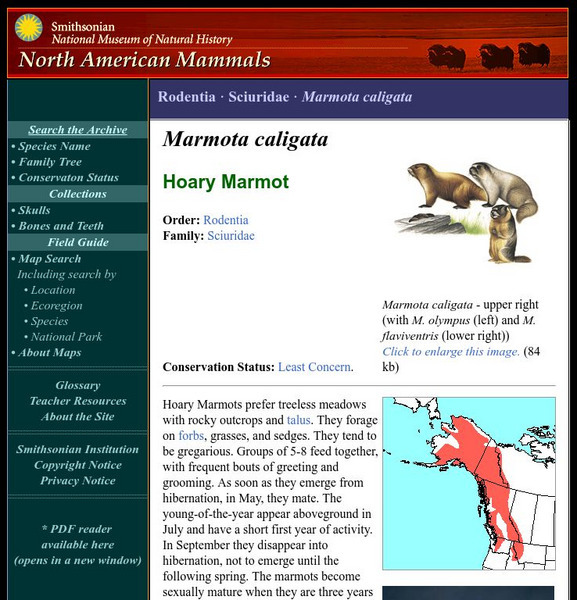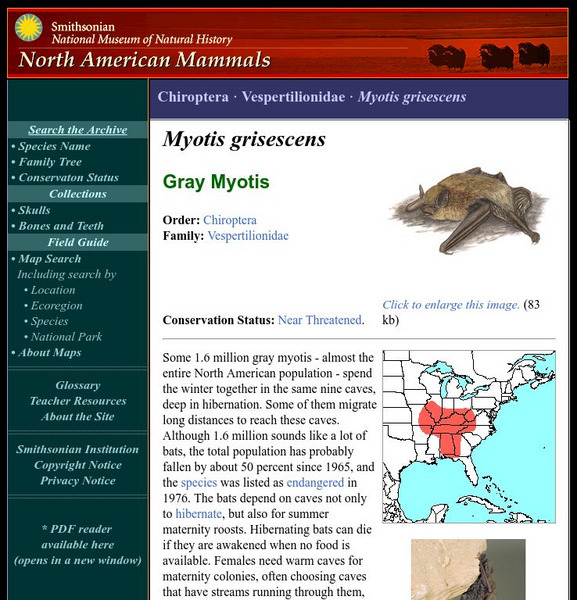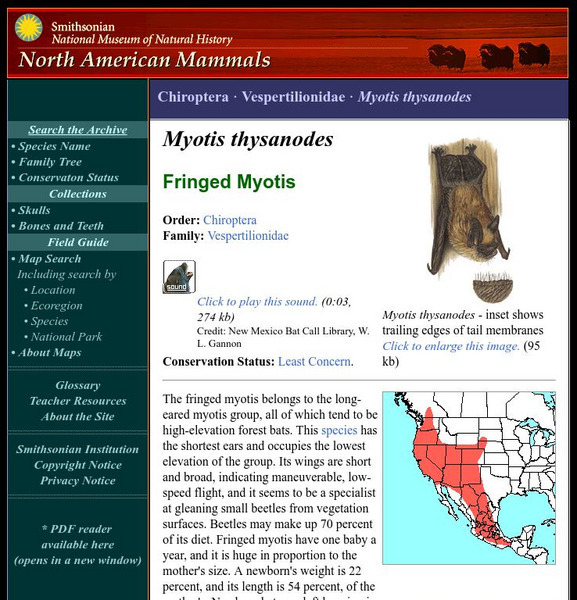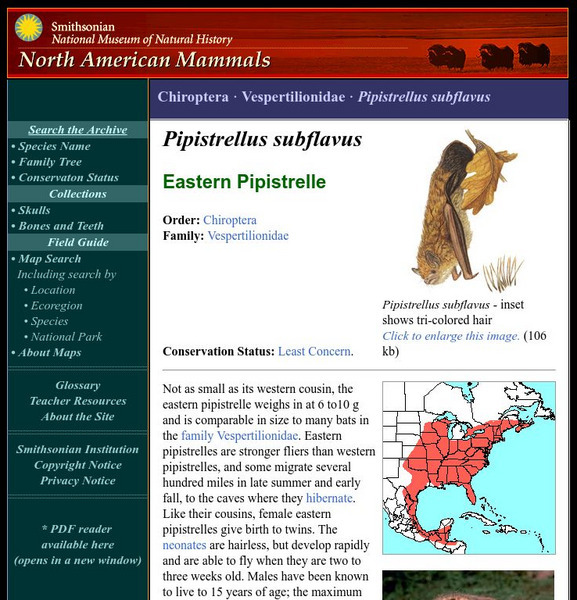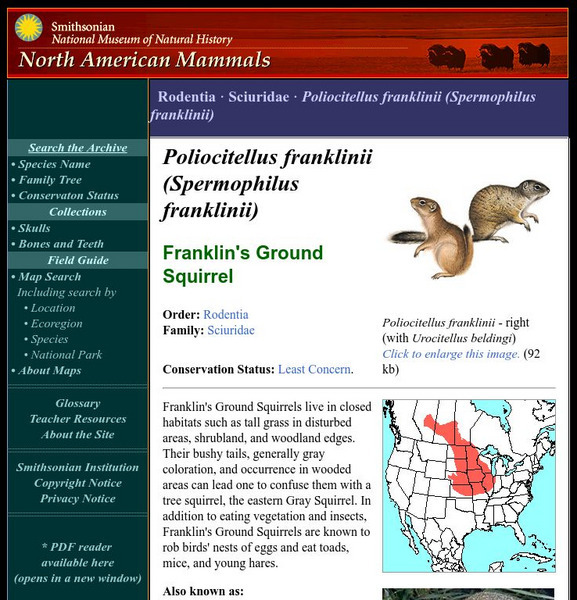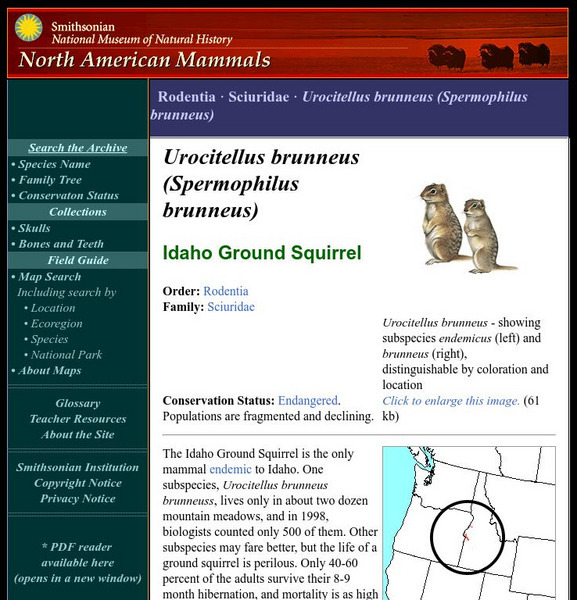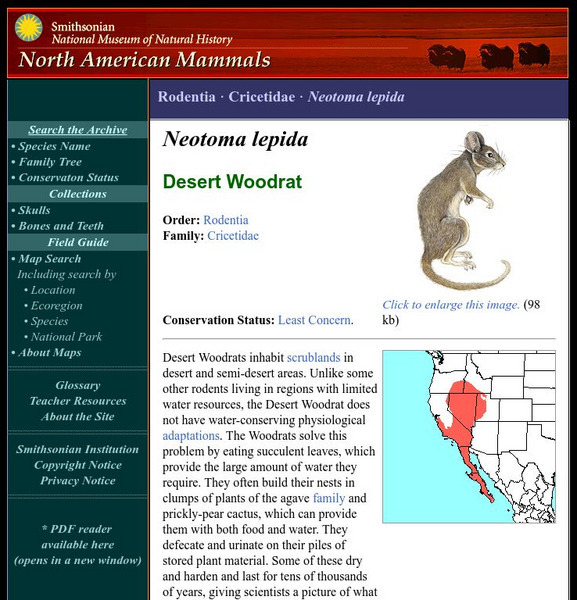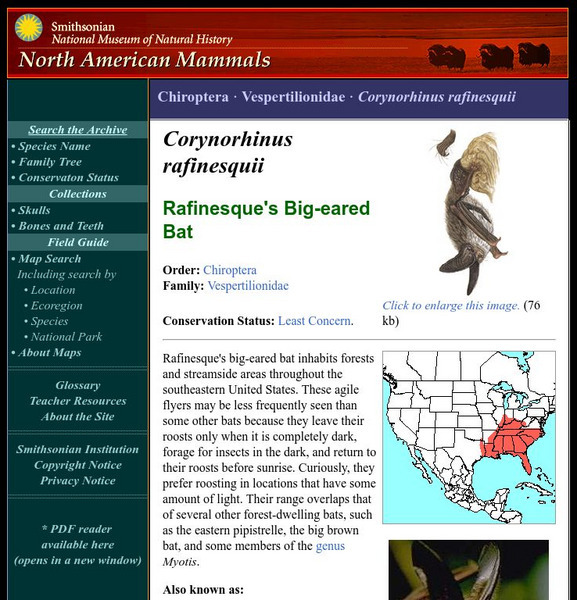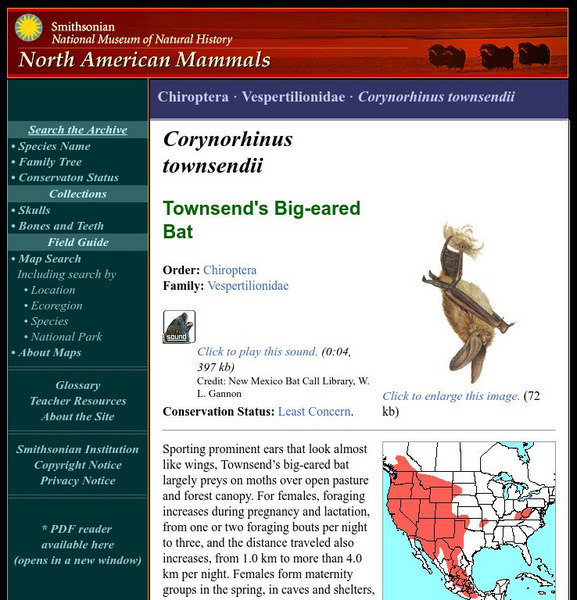Smithsonian Institution
National Museum of Natural History: American Mammals: Hoary Marmot
Hoary Marmots prefer treeless meadows with rocky outcrops and talus. They forage on forbs, grasses, and sedges. Learn more about the Marmota caligata, more commonly known as a Hoary Marmot, in this easy-to-read species overview by the...
Smithsonian Institution
National Museum of Natural History: American Mammals: Fisher
The Fisher is a forest-loving predator that eats anything it can catch, usually small-to-medium-sized rodents, rabbits, hares, and birds. It also eats carrion. Learn more about the Martes pennanti, more commonly known as a Fisher, in...
Smithsonian Institution
National Museum of Natural History: American Mammals: Ghost Faced Bat
Ghost-faced bats forage exclusively on large-bodied moths, and are strong, fast fliers. They spend their days in caves or abandoned mine shafts, and emerge soon after dark to fly to the arroyos and canyons where they forage. Learn more...
Smithsonian Institution
National Museum of Natural History: American Mammals: Gray Myotis
Some 1.6 million gray myotis - almost the entire North American population - spend the winter together in the same nine caves, deep in hibernation. Learn more about the Myotis grisescens, more commonly known as a Gray Myotis, in this...
Smithsonian Institution
National Museum of Natural History: American Mammals: Fringed Myotis
The fringed myotis belongs to the long-eared myotis group, all of which tend to be high-elevation forest bats. This species has the shortest ears and occupies the lowest elevation of the group. Learn more about the Myotis thysanodes,...
Smithsonian Institution
National Museum of Natural History: American Mammals: Little Brown Bat
Echolocation of little brown bats has been well studied since the invention of bat detectors, electronic devices that can "hear" the ultrasonic calls bats make, which are usually beyond the range of human hearing. Little brown bats...
Smithsonian Institution
National Museum of Natural History: American Mammals: Evening Bat
Evening bats that roost together seem to share information about the location of rich foraging patches and alternative roosting sites. When they forage on farms, they are a boon to farmers, because the bats eat cucumber beetles (the...
Smithsonian Institution
National Museum of Natural History: American Mammals: Eastern Pipistrelle
Not as small as its western cousin, the eastern pipistrelle weighs in at 6 to10 g and is comparable in size to many bats in the family Vespertilionidae. Eastern pipistrelles are stronger fliers than western pipistrelles, and some migrate...
Smithsonian Institution
National Museum of Natural History: American Mammals: Franklin's Ground Squirrel
Franklin's Ground Squirrels live in closed habitats such as tall grass in disturbed areas, shrubland, and woodland edges. Their bushy tails, generally gray coloration, and occurrence in wooded areas can lead one to confuse them with a...
Smithsonian Institution
National Museum of Natural History: American Mammals: Idaho Ground Squirrel
The Idaho Ground Squirrel is the only mammal endemic to Idaho. One subspecies, Spermophilus brunneus brunneus, lives only in about two dozen mountain meadows, and in 1998, biologists counted only 500 of them. Learn more about the...
Smithsonian Institution
National Museum of Natural History: American Mammals: Hairy Legged Vampire Bat
Vampire bats are amazingly well-equipped to live on a diet of blood and only blood - something no other mammal in the world does. Its teeth are so razor-sharp that the bird or mammal it feeds on usually does not even feel the tiny bite...
Smithsonian Institution
National Museum of Natural History: American Mammals: Eastern Woodrat
Eastern Woodrats are common in wooded areas with dense understories, in hedgerows, and in rocky outcrops. Their dens are occupied by a succession of individuals, each one adding more sticks and other material to the collection. Learn...
Smithsonian Institution
National Museum of Natural History: American Mammals: Dusky Footed Woodrat
Dusky-footed Woodrats, which are really very small rodents, build huge, elaborate houses of sticks. A house can measure more than a meter in diameter and be a meter high and one Woodrat may have as many as three houses. Learn more about...
Smithsonian Institution
National Museum of Natural History: American Mammals: Desert Woodrat
Desert Woodrats inhabit scrublands in desert and semi-desert areas. Unlike some other rodents living in regions with limited water resources, the Desert Woodrat does not have water-conserving physiological adaptations. Learn more about...
Smithsonian Institution
National Museum of Natural History: American Mammals: Hispid Pocket Mouse
"Hispid" refers to the coarseness of this pocket mouse's fur. Hispid Pocket Mice are larger and more robust than other pocket mice in their range, and like the others, they are solitary except in the breeding season. Learn more about the...
Smithsonian Institution
National Museum of Natural History: American Mammals: Western Pocket Gopher
As is the case with a number of pocket gopher species, most aspects of the Western Pocket Gopher's life have not yet been studied. This Pocket Gopher lives in rich volcanic soils of alpine meadows and small glacial prairies, west of the...
Smithsonian Institution
National Museum of Natural History: American Mammals: Northern Pocket Gopher
Of all North American pocket gophers, the Northern Pocket Gopher has the widest distribution, across most of the western United States and south-central Canada, and it occurs in the greatest variety of habitats. Only habitats with a...
Smithsonian Institution
National Museum of Natural History: American Mammals: Southern Pocket Gopher
Because most Southern Pocket Gophers live at high elevations in the mountains of Mexico, they are less accessible, and have been less-studied, than some other species. Like all pocket gophers, they are vegetarians, consuming both...
Smithsonian Institution
National Museum of Natural History: American Mammals: Mountain Pocket Gopher
Mountain Pocket Gophers live in meadows, pastures, and rocky slopes, in pine, fir, spruce, and hemlock forests at elevations above 1,545 m. They are active all year, and like other pocket gophers, they are solitary. Learn more about the...
Smithsonian Institution
National Museum of Natural History: American Mammals: Desert Pocket Mouse
The Desert Pocket Mouse is a common inhabitant of warm deserts throughout the United States and Mexico. It prefers sandy soil and avoids rocky settings, and like other pocket mice, comes out at night to search for seeds. Learn more about...
Smithsonian Institution
National Museum of Natural History: American Mammals: Western Red Bat
This close cousin to the eastern red bat (Lasiurus borealis) is genetically distinct. These bats are found along the west coast and the southwestern US and into Mexico where they are thought to hibernate in the winter. Learn more about...
Smithsonian Institution
National Museum of Natural History: American Mammals: Mexican Long Tongued Bat
Mexican long-tongued bats feed on fruits, pollen, nectar, and probably insects. The populations that summer in the United States migrate to Mexico and northern Central America in winter, following the blooming cycle of plants such as...
Smithsonian Institution
National Museum of Natural History: American Mammals: Rafinesque's Big Eared Bat
Rafinesque's big-eared bat inhabits forests and streamside areas throughout the southeastern United States. These agile flyers may be less frequently seen than some other bats because they leave their roosts only when it is completely...
Smithsonian Institution
National Museum of Natural History: American Mammals: Townsend's Big Eared Bat
Sporting prominent ears that look almost like wings, Townsend's big-eared bat largely preys on moths over open pasture and forest canopy. For females, foraging increases during pregnancy and lactation, from one or two foraging bouts per...
